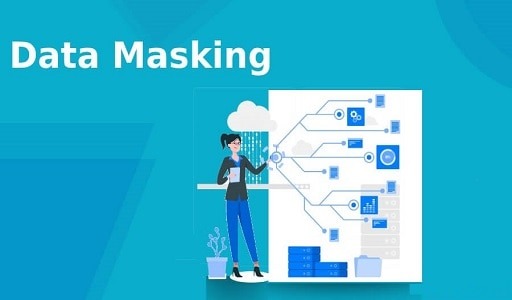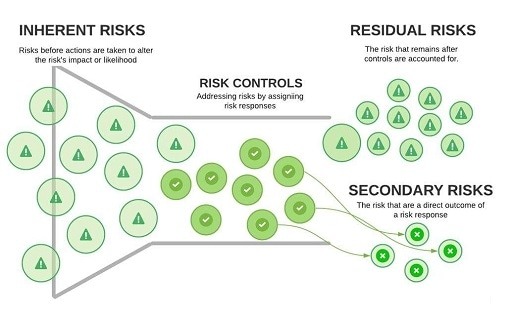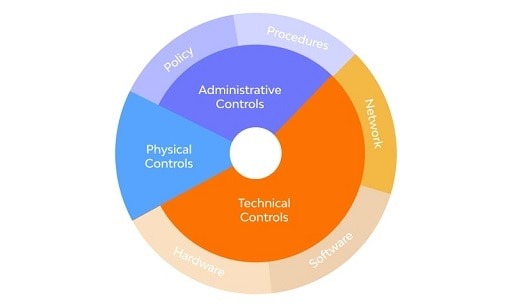As the world is getting ever closer to digital reality, it becomes important to protect yourself and your business from cybersecurity attacks.
Cybersecurity threats can cause devastating effects on businesses and individuals, including damage to reputation, loss of data, and financial losses. This may lead to a loss of credibility and trust, which could be hard to manoeuvre in the business world, negatively affecting your bottom line or even leading to closure.

Fortunately, there are several ways you can help protect yourself and your business against these threats. From firewalls to password management, the following tips will keep you ahead of the potential threats and your data safe.
What is cybersecurity?
Cybersecurity is how security is applied to protect systems, networks, programs, and data from electronic attacks. Many attacks normally attempt to alter, access, or destroy sensitive information, or seek ransom from users to impede business processes.
Cybersecurity is also a collection of practices intended to help protect computers, networks, programs, and data from unauthorized access, attack, and destruction. Nowadays, the concern of cybersecurity has grown a lot more critical since the number and intensity of cyber-attacks increase day by day.
Would you like to learn how to secure yourself and your business from cyber-attacks? If so, then an SBU cybersecurity online master’s program would be your ideal choice.
The course will help you to become knowledgeable in cloud security, data mining, networking, and many other aspects. Furthermore, you will be able to design, implement, and assess security solutions against current and emerging technologies.
What is a cyber-attack?
A cyber-attack is any malicious attempt to access or damage computer systems, networks, and data. Cyber-attackers use various techniques to gain unauthorized access to systems, such as exploiting vulnerabilities in software, using malware, or cracking passwords.
Most commonly, cyber-attackers use malicious code to take control of an organization’s systems. By doing so, they can steal sensitive information, corrupt data or hold systems hostage for ransom.
The goal of a cyber-attack can vary greatly depending on the attacker’s objectives. For instance, some aim to disrupt services or business operations, while others seek financial gain.
You can also read: How to Keep Your PC safe and Secure from Viruses and Cyber Attacks
Sometimes, cybercriminals may conduct the attack for political or ideological purposes. No matter the intent, a cyber-attack seriously threatens any organization or individual. Everyone must know the most common forms of cyber-attacks and understand how to protect themselves against them.
Examples of cyber-attacks
Below are some examples of common cyber-attacks.
-
SQL injection
SQL injection is a type of cyber-attack that takes advantage of vulnerabilities in web application code to inject malicious SQL statements into the backend database. Attackers exploit these vulnerabilities to access confidential information, modify existing data, or delete data altogether.
It is one of the most common and severe types of cyber-attacks and can have far-reaching consequences. In an SQL injection attack, an attacker attempts to gain unauthorized access to a database by entering malicious commands into web forms or online text boxes.
These commands give an attacker access to the backend database, which allows him or her to extract confidential information or modify the existing data. Attackers frequently exploit SQL injection in applications with poor security measures.
SQL injection is quite serious and has posed a huge threat to many organizations. Every organization should, therefore, be concerned about web application security that does not let any vulnerability pass. This means proper security in regard to databases and the development of web applications by properly coding and testing.
-
Distributed denial-of-service (DDoS)
A distributed denial-of-service (DDoS) attack is one of the most commonly seen cyber-attacks today. It is an attack designed to overwhelm a targeted server or network by flooding it with malicious traffic from multiple sources.
In essence, it is an attack that attempts to take down a website or other online service by flooding it with too much traffic. Hackers can use DDoS attacks for various purposes, such as political activism, sabotage and extortion.
Attackers can also use them to disrupt business operations by temporarily taking down critical systems or causing significant outages. The most common form of DDoS attack utilizes botnets, which are networks of computers that have been infected with malicious software and are controlled remotely.
These botnets can send large amounts of data to the target system to overwhelm it. DDoS attacks may also use specific techniques, such as reflection and amplification, to increase the traffic sent.
-
Cross-site scripting (XSS)
Cross-site scripting (XSS) is an attack that exploits an application’s vulnerability to execute malicious scripts within the user’s browser. This attack targets users by injecting malicious code into websites, web applications or webpages that the user visits.
When a user visits a compromised website or webpage, hackers can use malicious code to access confidential information such as login credentials, cookies and other personal information. XSS attacks are among the most common cyber-attacks, often resulting in data breaches.
You can also read: Blue and Red Teams in Cybersecurity
These attacks work by exploiting vulnerabilities in web applications. Once the malicious code is injected, it can steal user credentials, redirect users to malicious websites, or inject malicious code into the vulnerable website.
The attacker then can access confidential information and use it for malicious purposes. To protect against XSS attacks, web developers should keep updated on security patches and use encryption when handling user information.
-
Password sniffing attacks
Password sniffing is a cyber-attack in which a malicious actor attempts to capture network traffic to steal sensitive data, including usernames and passwords. These attacks involve packet sniffers or software that can detect, intercept and interpret data as it is transmitted across networks.
This attack aims to obtain user credentials that hackers can use to access the target system. To do this, attackers look for passwords in transit, usually plaintext.
Many of these passwords are transmitted across the connection in plain text and can be sniffed readily by a packet sniffer.
When obtained, the attackers may use the stolen credentials to access other parts of the target system or to launch additional attacks against it.
How to Protect Yourself and Your Business from Cybersecurity Attacks
We are living in a digital world, and the number of cyberattacks is growing day by day. From data breaches to phishing scams, hackers find ways to get their hands on our information.
The following are 10 efficient methods that you can use to protect yourself and your business from cybersecurity attacks.
Use strong passwords
The use of strong passwords in relation to cybersecurity remains one of the best ways of protecting either yourself or your business from cyberattacks. Strong passwords should contain at least eight characters that must combine both uppercase and lowercase letters, numbers, and symbols.
It’s best to avoid using the same password for multiple accounts and not to share your passwords with anyone else. Consider using a password manager to help create and store secure passwords.
Consider enabling two-factor authentication (2FA) as an added security layer. This requires users to provide two forms of identification when signing into their accounts, such as a password and a code sent via text or email.
-
Avoid phishing emails
Phishing is a cyber-attack in which malicious actors attempt to acquire personal information, such as passwords and credit card details, by pretending to be a legitimate source.
Phishers use emails that look like they’re from legitimate sources to trick the recipient into revealing sensitive information or clicking on links that lead to malicious websites. It is important to remember that legitimate companies will never ask for sensitive information via email.
An email that looks suspicious should not be opened or responded to. When it comes to your staff, it is vital to ensure that they are aware of the dangers of phishing emails and that they know how to spot them.
Educate them on the signs of a phishing email, such as spelling mistakes, requests for personal information, or links to unfamiliar websites.
-
Keep your software up to date
With the advancement of technology, the threats of cybersecurity are also growing. Hence, keeping your software updated will help you protect yourself and your business from malicious attacks.
Regular updating of software keeps the bugs and vulnerabilities patched, which helps in the efficient running of the system. You can keep your software up to date by a few methods.
First, always install any updates or patches for your operating system, web browser, and other software applications. You also need to stay informed about the latest releases and updates of the software you are working with.
Thirdly, if you are on some open-sourced applications or programs, then keep checking for updates periodically. Review all your systems from time to time and keep them updated to ensure the best level of security.
-
Get advice on Cyber Security
Perhaps one of the best ways you can protect yourself and your business from cybersecurity attacks is to get professional advice. Seek advice from a cybersecurity expert and/or consultant who can help you discuss your needs, assess the risks, and recommend ways to protect your business.
They can help identify potential weak spots in your system and thus devise strategies to keep data safe. Besides hiring consultants, some resources can be found online that can help one understand cybersecurity issues and make informed decisions about how to protect their business.
You can also read: Blue and Red Teams in Cybersecurity
You can also review industry reports, research products and services, and attend webinars. You can protect your business from potential attacks with some research and knowledge.
-
Create policies for your staff
Creating policies for your staff is essential for protecting your business from cybersecurity attacks. The key is having clear, detailed guidelines that everyone can understand and follow.
Start by documenting the roles and responsibilities of all employees, including information about the company’s data security and usage. Ensure that all employees understand their obligations in regard to the policy and know of any potential risks associated with using technology.
Set rules and guidelines for using devices, software applications and social media sites. Lastly, include a disciplinary system in the policy so that anyone who violates the policy will be held accountable.
This action will encourage people to take responsibility for their actions and better protect your business from cybersecurity attacks.
-
Educate and train your staff
Training your staff on cybersecurity is essential for protecting your business from cybersecurity attacks. Ensure that all your employees understand the importance of data security, the risks associated with not following best practices, and how to identify and respond to potential threats.
Additionally, provide ongoing training to update employees on any new procedures or technology that your company implements. Make sure that your staff know all the basic security principles and protocols, such as using strong passwords, avoiding phishing emails, and using 2FA.
You should also encourage them to report any suspicious activity to the appropriate person in your organization so that you can investigate it promptly. By training your employees on security measures, you can create a more secure environment for your business and protect it from potential attacks.
-
Use multi-factor authentication (MFA)
Multi-factor authentication (MFA) is a security measure requiring more than one verification form to access an account or system. This additional layer of security significantly reduces the chances of a cybersecurity attack by making it much more difficult for unauthorized users to gain access.
When setting up MFA, you will typically be asked to set up two or more authentication factors. These can be a combination of something you know or have.
Using MFA significantly reduces the risk of cybersecurity attacks by adding an extra layer of security to your accounts and systems. It also ensures that only authorized users can access your information and data, which is essential for protecting your business and its customers.
-
Encrypt important information
Encryption means encoding data so that a user cannot read it without a key or password. When encrypted, data is converted into a form that can only be read by those with the correct key or password.
Encryption is used for both data in transit and data at rest. Data in transit refers to data moving from one location to another, such as an email or file transfer.
On the other hand, data at rest refers to data stored on devices such as computers and phones. When encrypting essential data, you can use several methods depending on your needs.
The most common type of encryption is Advanced Encryption Standard (AES), used for transit data and at rest. You can also use other types of encryption algorithms, such as Twofish and Blowfish, depending on the level of security you need.
Remember that encryption is not foolproof, as someone can still break it if they can access your key or password. This is why it’s important to choose strong passwords and change them frequently and store the key or password in a secure location.
-
Back up your data
Backing up your data is essential for protecting your business from cybersecurity attacks. It’s important to regularly back up sensitive or critical data, such as customer information, financial documents, etc.
You should also consider implementing a remote backup system for added protection. With a remote backup system, you can store your data offsite securely, ensuring that it is protected against any local threat.
Select an encryption method when transferring the data so that it remains secure during transit.
You should also regularly test the backup system to make sure that it functions appropriately and adequately protects your data.
Finally, create new backups regularly so that you have a recent copy of your important data in case of a security breach. This will help reduce the amount of data lost if an attack occurs.
-
Monitor the use of computer equipment and systems
You must monitor computer equipment and systems to address cybersecurity threats quickly. This can include tracking users’ activity on your network, using logs to identify suspicious activities, and setting up alerts for unusual activities.
Implementing a system for monitoring users can also help you detect malicious behavior and protect your business from potential cybersecurity attacks. Consider setting up regular system scans to identify any potential weaknesses in your security protocols.
It is essential to track who can access your data and networks and what they can do with them. It is vital to stay aware of any new technologies or software that hackers could use to breach your systems and networks.
By monitoring your system regularly, you can identify and address any security issues as soon as they arise.
Final thoughts
Cybersecurity is an ongoing battle that requires vigilance and a commitment to staying up to date with the latest trends in technology. Following the tips and advice outlined in this blog post can enable you to better protect yourself or your business from cybersecurity attacks.
As hackers become more sophisticated, we must stay one step ahead and employ the necessary precautions to ensure that our data remains secure.
Strong passwords, encrypting sensitive data and educating staff are all necessary components of a sound cybersecurity strategy. Investing in a cybersecurity plan can save you from costly losses in the long run.
Would you like to read more about How to protect yourself and your business from cybersecurity attacks-related articles? If so, we invite you to take a look at our other tech topics before you leave!










